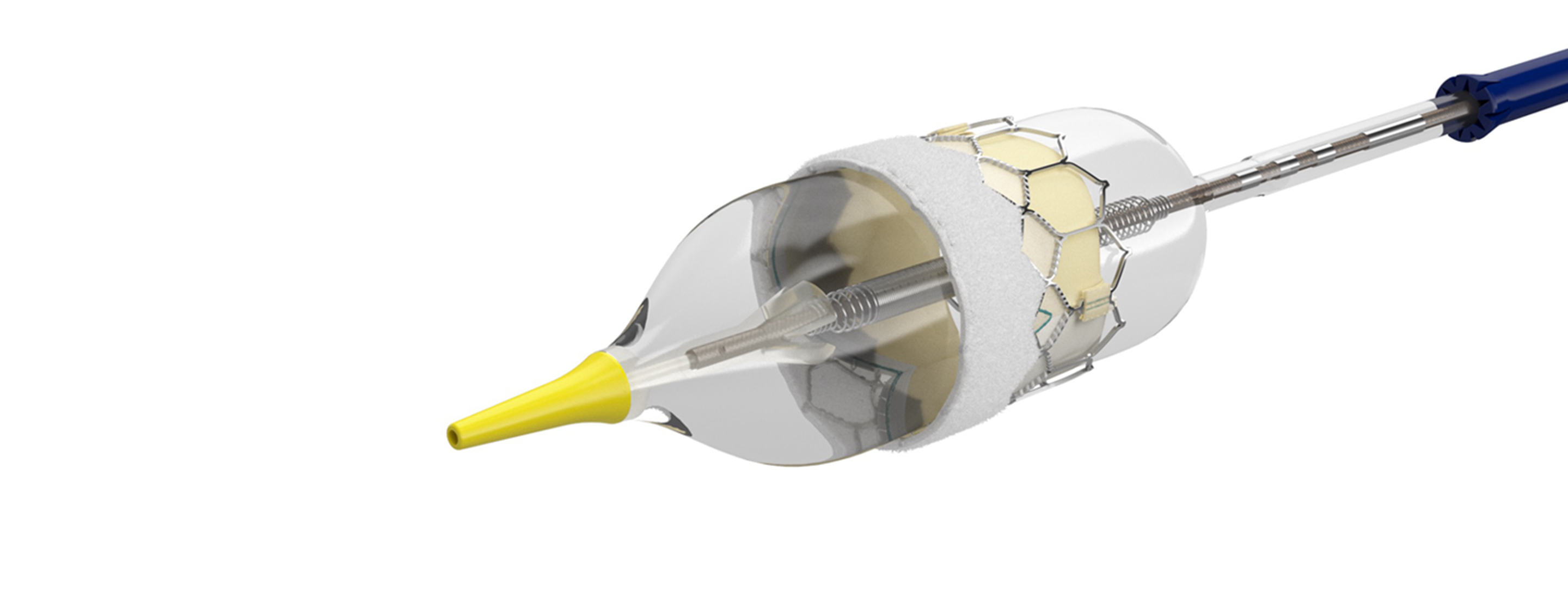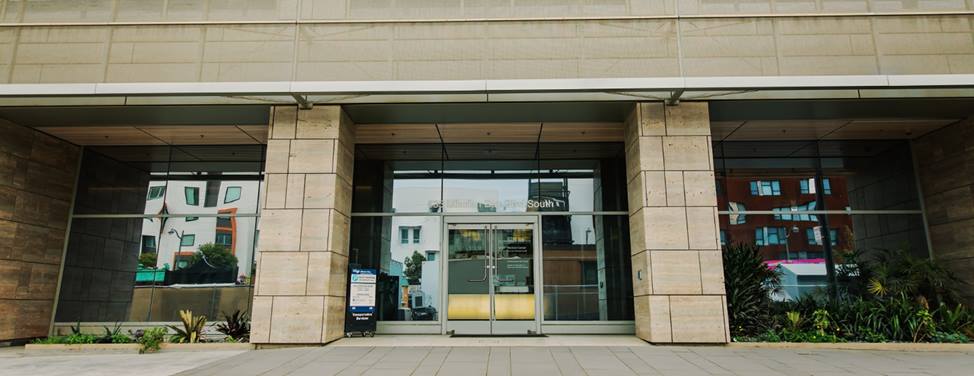Transcatheter aortic valve replacement (TAVR) is a minimally invasive procedure for treating aortic valve stenosis. As blood exits the heart, it passes through the aortic valve. In patients with aortic stenosis (one type of aortic valve disease), the valve is stiff and narrow, and doesn't open and close as it should, making it harder for the heart to pump blood to the body. As a result, patients feel short of breath and fatigued, and are at high risk for a heart attack.
The only treatment for aortic valve disease is to replace the valve, which traditionally required open-heart surgery. For many patients, however, TAVR is an equally effective, much less invasive alternative. Instead of opening the chest to remove and replace the damaged valve, the doctor threads a catheter (a thin, flexible tube) through a blood vessel to reach the heart, then inserts a new valve inside of the faulty one, restoring healthy blood flow. The procedure takes much less time than open-heart surgery, and patients recover more quickly, with less pain and scarring.
UCSF has a comprehensive valve program that offers catheter-based treatment options for all four valves in the heart.
Evaluation
While TAVR was originally developed specifically for patients at high risk with open-heart surgery, it's now approved for anyone with severe aortic stenosis. To determine whether it's a good option for you, our team of heart specialists will evaluate your heart health as well as your overall health. You may have all or some of the following tests as part of the evaluation:
- Blood tests help doctors assess your health. These will likely include a red blood cell count, which indicates how much oxygen is being delivered to your body's cells; electrolyte levels, which can be disturbed by an underlying illness; and tests to measure substances in the bloodstream that reflect how well your kidneys, liver and thyroid are working.
- A chest X-ray can show the size of your heart and reveal whether you have fluid buildup in your lungs.
- An electrocardiogram (EKG) is a painless test to assess the heart's electrical activity. Electrodes are taped to your chest, arms and legs to record and measure the signals that cause your heart to beat.
- A transesophageal echocardiogram (TEE) is a heart-imaging test in which an ultrasound probe is put into your esophagus in order to obtain clear images of your heart's chambers and valves, and assess how blood flows through your heart.
- A cardiac MRI or cardiac CT scan provides detailed images of your blood vessels, the blood flow through your heart, and your heart's structure and motion.
- Right heart catheterization may be performed to obtain more information about how well your heart is pumping. A catheter is inserted through a blood vessel and threaded into the heart, where it measures the blood pressure in your heart and in the main arteries of your lungs. The catheter can also measure cardiac output and blood oxygen levels.
If your doctor suspects that you have coronary artery disease in addition to aortic stenosis, you may also have these tests:
- An angiogram provides images of the heart's blood vessels, so that blockages can be detected. A catheter is inserted into a blood vessel (usually in the groin area) and threaded up to the heart. A contrast dye (a harmless substance that shows up well on X-rays) is injected through the catheter, and X-ray images track the blood flow to your heart muscle.
- A stress test shows your heart's response to exertion. You'll either be given medication that makes your heart work extra hard or asked to exercise (on a treadmill or stationary bike) while your vital signs are tracked and your heart's response is monitored.
If the evaluation indicates you would benefit from TAVR, our cardiac care team will make a treatment plan for you. Each patient's team includes a cardiologist, cardiac surgeon, interventional cardiologist, nurse practitioner and imaging specialist.
Getting ready for a TAVR
Our team will set you up for an appointment with the UCSF Prepare Program, which is dedicated to ensuring that patients are ready for their scheduled procedures, including the completion of all required testing. The Prepare staff will review your medications to be certain you have the correct instructions regarding their use, and they'll discuss your pain control options. They will share all communications and information with the TAVR team.
How you can prepare:
- Talk to your doctor about your medications. Find out which you should or shouldn't take on the days leading up to your procedure, on the day itself, and on the following days.
- Get a dental checkup, because oral bacteria can infect the valve.
- Make a recovery plan. It's important to work out details, such as who will take you home, stay with you, and help you prepare meals.
The procedure
We perform TAVR procedures in a state-of-the-art operating room at the UCSF Helen Diller Medical Center at Parnassus Heights. Before the procedure, you'll have an echocardiogram (heart ultrasound), then we'll bring you to the operating room. Our team will have determined the type of anesthesia they'll use for you, as the best choice depends on certain health factors. You may be fully asleep (given general anesthesia), or you may be awake but sedated enough to be relaxed and not feel pain.
After the anesthesia is started, the doctor will make a small incision near your groin and insert the catheter into the major artery there. The doctor will use this to convey a new valve – in a collapsed state that allows it to pass through the catheter – to your heart. (Sometimes another artery has to be used; if that's the case for you, your doctor will let you know well in advance.)
As part of the procedure, we will place a temporary pacemaker to ensure your heartbeats stay regular. In many patients, we also insert a Sentinel filtration device into a blood vessel in your neck; this lowers the risk of stroke by preventing tiny bits of plaque that might be dislodged during the procedure from traveling to your brain. We insert the device through a small incision in your wrist.
The catheter carrying the replacement valve is threaded through the blood vessel until it's inside your damaged valve. Once in place, the new valve is expanded to full size. It pushes aside the "leaflets" of the old valve – the flaps that open and close – and takes over the job of regulating blood flow from the heart. The new valve is typically made of bovine or porcine tissue; both are compatible with human tissue.
After the valve is placed, the temporary pacemaker is removed. (If a slow heart rate is detected, we may wait until the following day to remove it.) The Sentinel device in your neck is also removed. The whole operation takes about two to three hours – half as long as open-heart surgery.
Another echocardiogram is performed immediately after the procedure to assess function of the new valve. You'll then be taken to the recovery area.
Recovery
Immediately after the procedure, you'll recover in the post-anesthesia care unit, then be transferred to either our transitional care or intensive care unit, depending on the level of care you need. Patients are encouraged to be up and walking within 24 hours. Most patients spend one to two nights in the hospital, where they are closely monitored. During your hospital stay, your cardiac care team will conduct several follow-up tests, including a chest X-ray, EKG and echocardiogram, to ensure your heart is functioning properly.
Before you go home, your team will talk with you about caring for yourself, covering topics such as diet, exercise, care of your incision sites, and any new medications. After discharge, you'll need to have regular checkups with your primary care doctor, local cardiologist and the heart team, as necessary. These checkups are important for ensuring all is well with your new valve and detecting any potential problems early.
Particularly during the first weeks of recovery at home, be mindful of how you're feeling. If you experience unusual headaches, dizziness or other concerning symptoms, call the doctor who performed your procedure immediately or dial 911.
We advise patients not to drive for at least 72 hours after the procedure (to allow the incisions to heal) and to avoid strenuous physical activity for 10 days. TAVR recovery is much faster than recovery from open-heart surgery, and most patients can resume normal activities within two weeks.
Some patients benefit from a cardiac rehabilitation program, in which a team of health care professionals provides an individualized exercise plan, education and support to help you improve your heart health and quality of life. Ask your doctor whether cardiac rehab is right for you.













